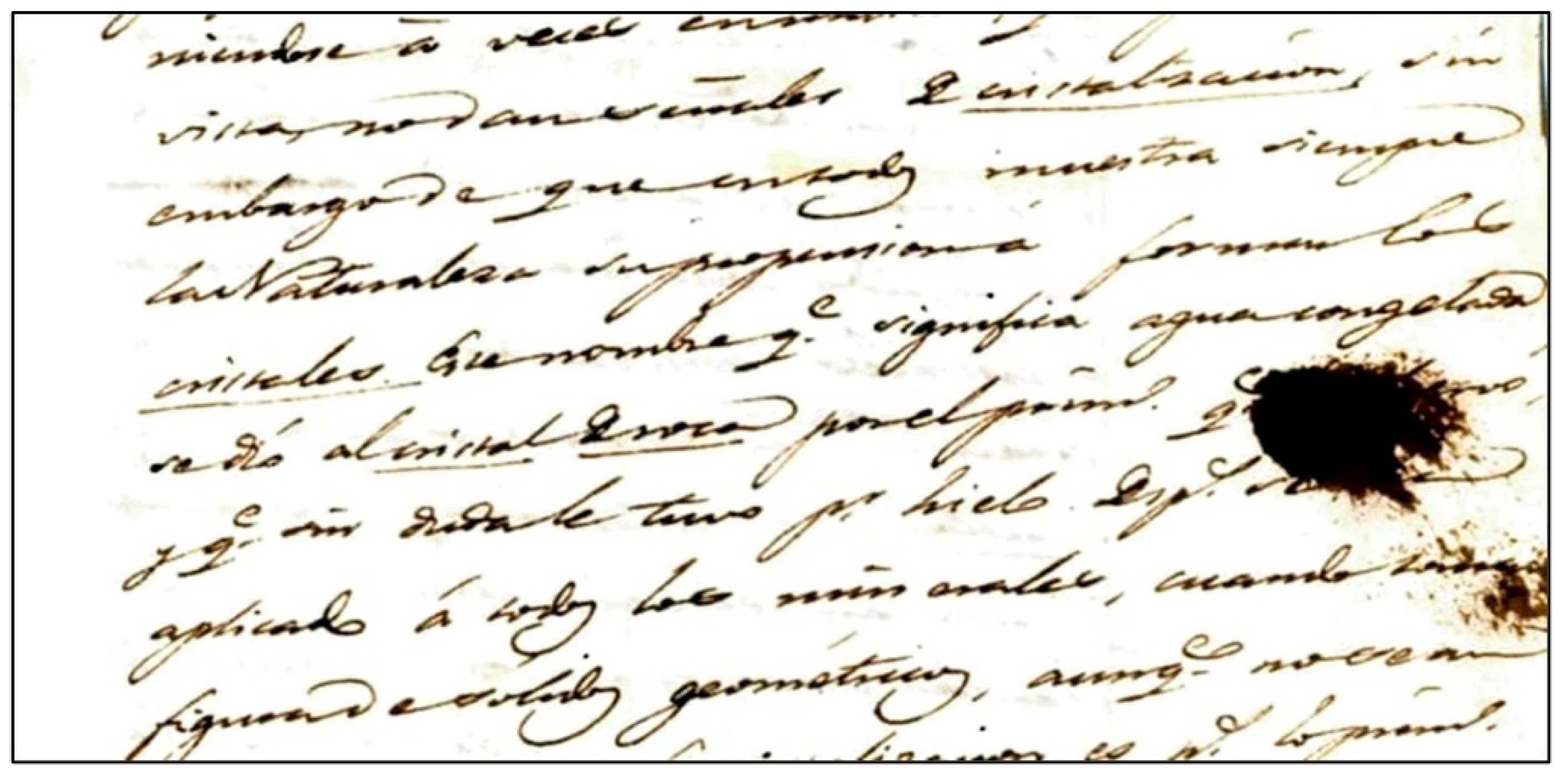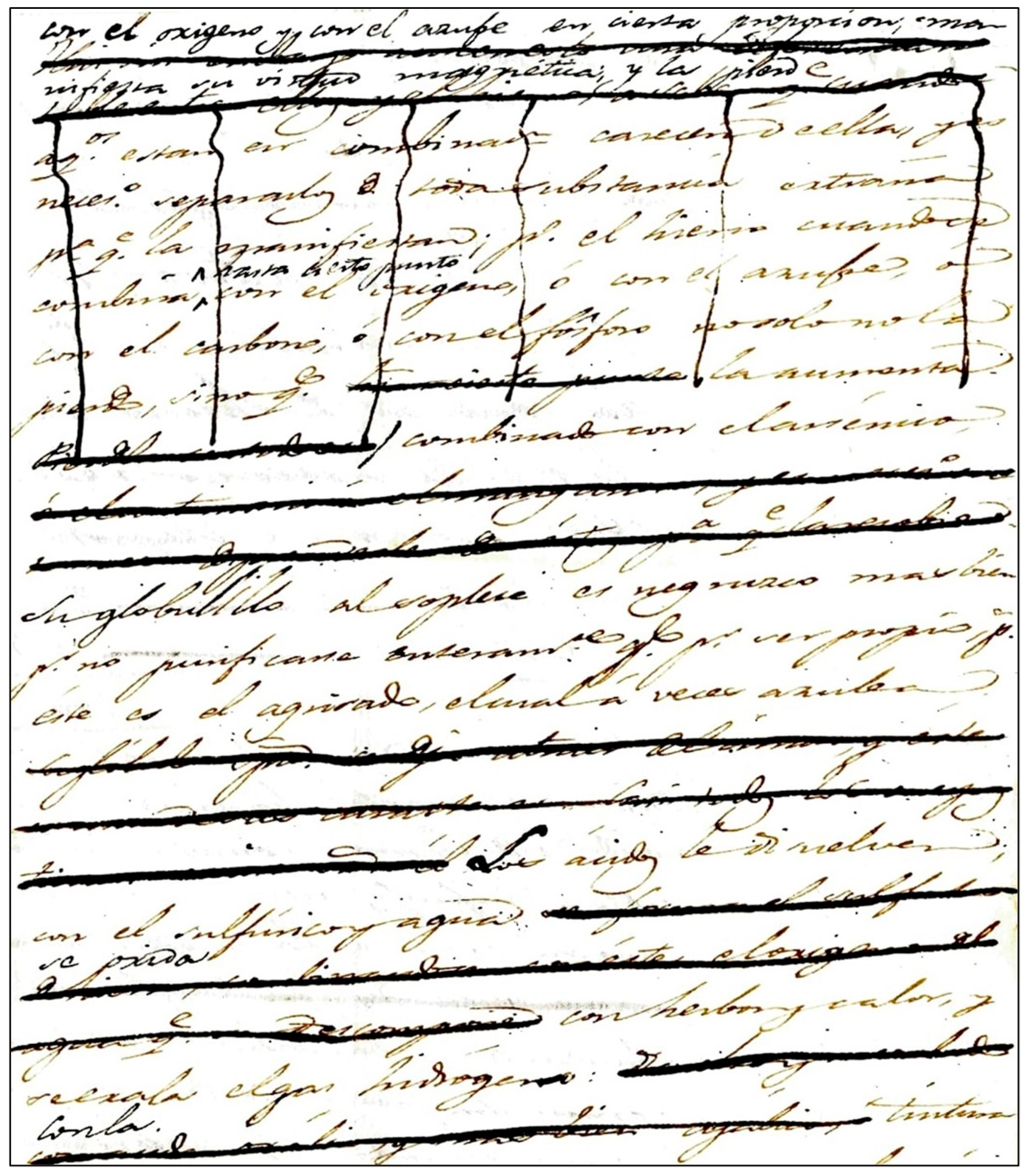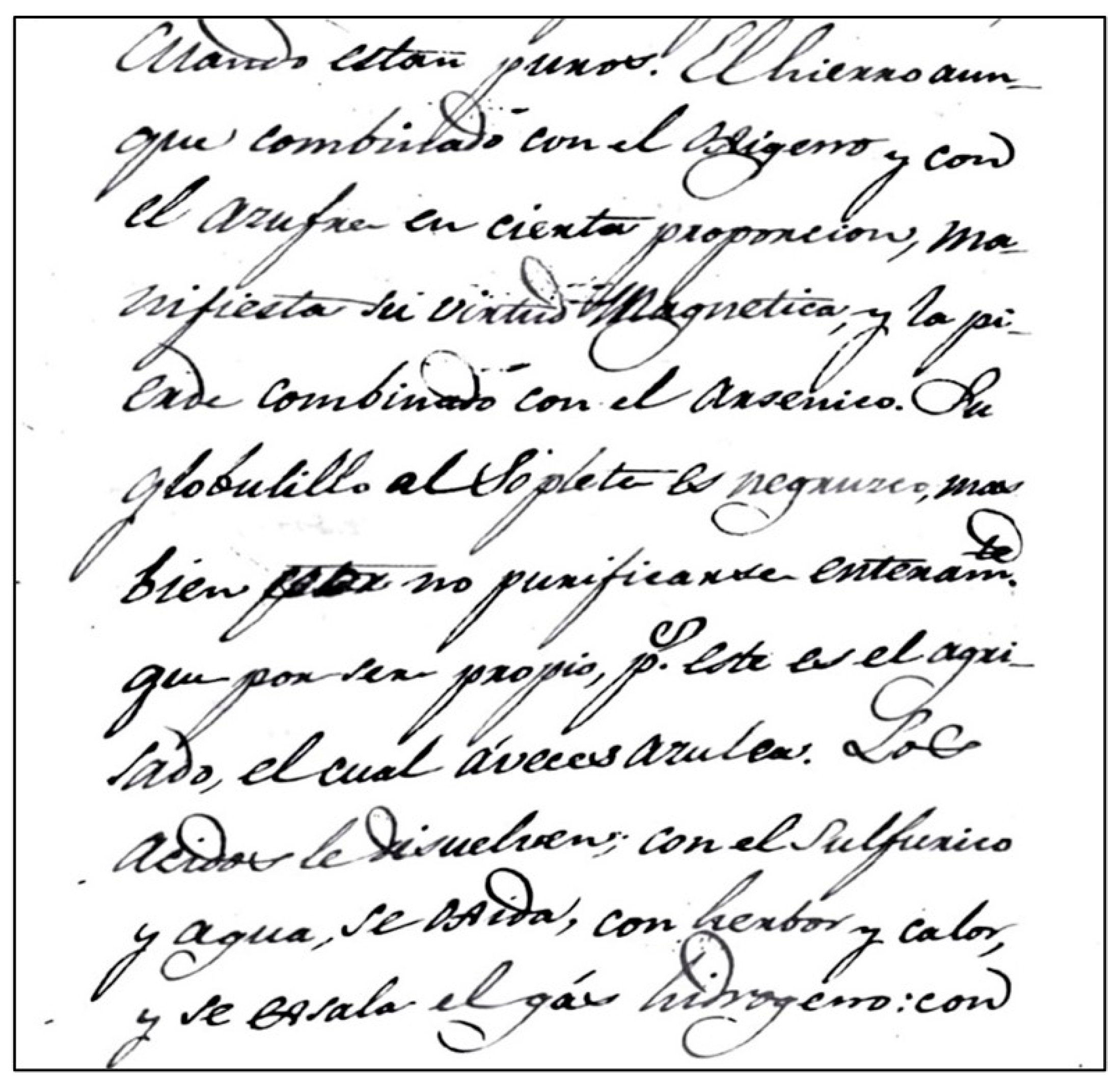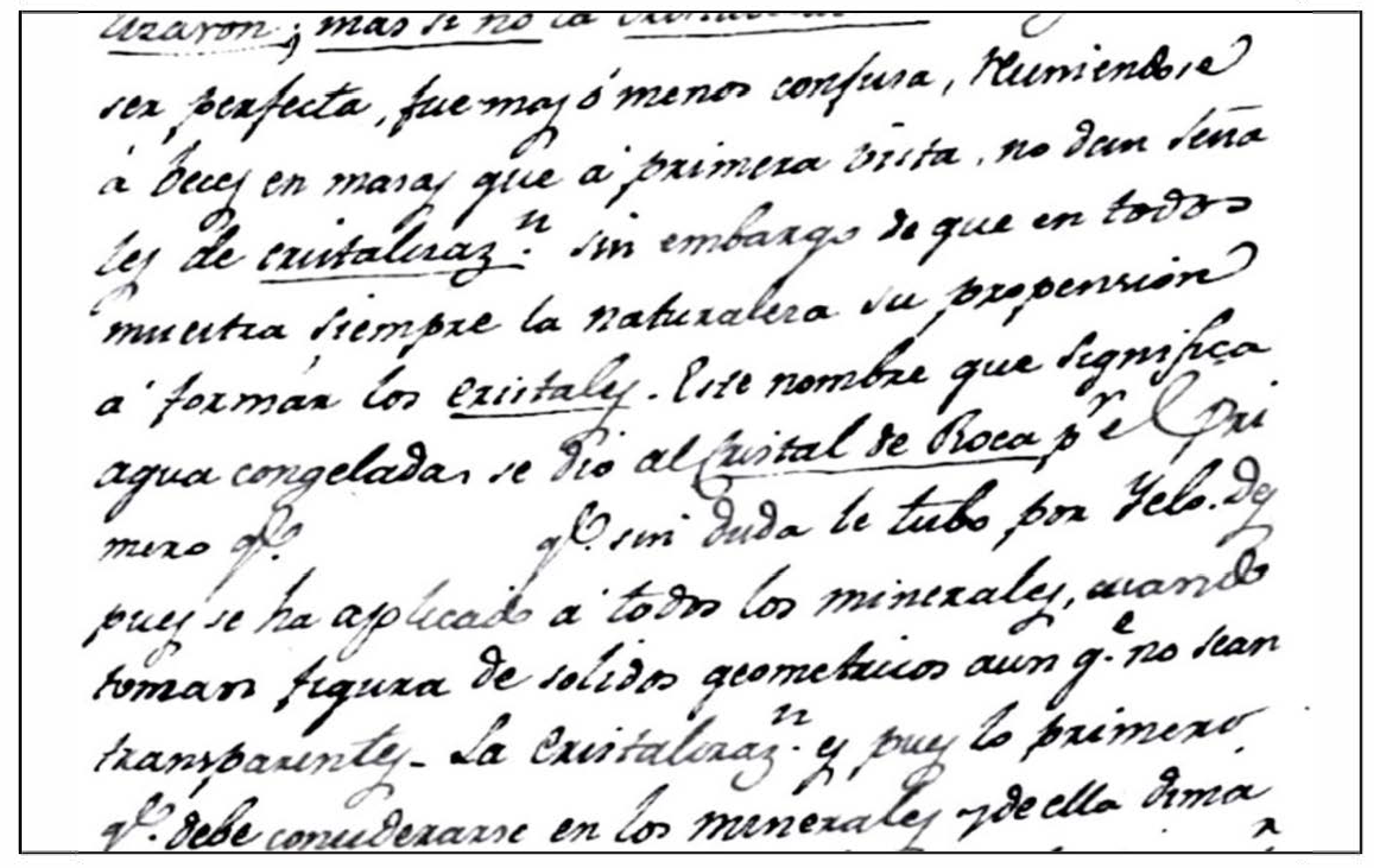1. Introduction
Donato García Negueruela (1779–1855) [
1,
2,
3,
4,
5,
6] was a Spanish botanist, mineralogist, and priest, recognized as the first professor of mineralogy who developed his academic career at the Royal Cabinet of Natural History. As a professor, he promoted the training of future generations of Spanish scientists and professionals. Among his students, it is important to highlight José Musso y Valiente (1785–1838). With a broad education, this humanist and politician actively participated alongside Professor García in the document investigated here.
This research is set within a time frame contextualized by the loss of the most important portion of colonial territory in the early decades of the 19th century, which led, among other things, to a return to the peninsular territory. The establishment of a national “educational system” enabled the creation of educational institutions (especially at the secondary and university levels) throughout the country.
Professor García oversaw Mineralogy classes at the Royal Cabinet of Natural History (RGHN) in Madrid (Spain) from the death of Christian Herrgen in 1816. Thirty years later, he occupied the chair of Mineralogy at Universidad Central until his retirement in 1853. However, being one of Herrgen’s best disciples, he served as his assistant in 1814 and collaborated with the German mineralogist in publishing a work on Mineralogy, as Widenmann’s book [
7], which had been used as the reference text until then [
8] and was considered outdated. This work was based on the importance of external characteristics for mineral classification [
9], following the ideas of Professor Abraham Gottlob Werner (1749–1817). However, the controversy between Werner’s ideas and the new concept introduced by Romé de L’Isle (1736–1790) and the abbé René Just Haüy (1743–1822) regarding crystalline morphology is clearly observed in the Anales de Historia Natural [
10]. Donato García was not oblivious to European scientific trends, a fact that is evident in the modifications and updates he made to his lessons known to date: manuscripts from 1821 (“Alberto Gomis” Collection), the AGP manuscript, and the lessons published by Cisneros y Lanuza (1843).
The Mineralogical Lessons from Archivo General de Palacio (AGP manuscript) on display refers to the lessons given in the 1824–1825 academic year under the title “Mineralogy lessons explained by Donato García at the Royal Cabinet of Natural History in Madrid” [
5].
The assimilation of these changes was reflected in the modification of the mineral classifications used during his teaching, which led to substantial changes in his teaching program. Thus, he referenced both Werner’s external characteristics of minerals and Haüy’s crystallographic system. Due to the absence of Spanish-language texts to follow the classes at the RGHN’s Chair of Mineralogy, many of his students often opted to take notes. According to José Musso Pérez-Valiente [
5,
11], the lack of a Spanish-language bibliography was supplemented with printed lessons by the professors, such as Antonio Sandalio de Arias’s (1773–1839) Agriculture classes. With the same intention, the manuscript examined in this work relates to Donato García’s Mineralogy classes. This practice was common among his students, as evidenced by the preservation of manuscripts related to his classes at the RGHN, such as “the 1821 Mineralogy lessons manuscript” [
3] or those published by Antonio María de Cisneros y Lanuza in 1843 [
5,
12]. Similarly, José Musso’s diary preserved in the Calasparra Municipal Archive (Murcia, Spain; AMC, Conde del Valle de San Juan, Murcia, Personal, Diarios) and his life memorial [
5,
11] refer to the correction process based on Musso’s notes and to his close scientific collaboration to produce the AGP manuscript and demonstrate the authorship of the manuscript preserved in the AGP (AGP, Infante D. Gabriel y sucesores, Anexo, legajo 4).
Moreover, the AGP document expands knowledge about the most significant figures of the European scientific movement related to Mineralogy that developed in the early 19th century. It contains references to around a hundred prominent individuals, including chemists, mineralogists, and geologists, providing valuable information and highlighting Professor García’s bibliographic sources. This finding sheds light on his Chair of Mineralogy and the teachings of the early 19th century, and it represents the most reliable evidence of Donato García’s teaching work at the RGHN in Madrid (Spain).
2. Materials and Methods
For the research on the manuscript of the Mineralogy lessons from the 1824–1825 course held at the AGP in Madrid (Spain), a complete transcription of the document has been carried out by the authors. Additionally, another transcription has been made of the Mineralogy notes of José Musso located in the Lorca Municipal Archive (Murcia, Spain; AML, Fondo Casa de Guevara. Originales, Caja n.º 1). This is the Musso manuscript [
5], which corresponds to the course mentioned in the AGP manuscript and subsequent ones, in the form of additions, up to the 1828 course.
The lessons from the manuscripts have been transcribed into electronic format. Accordingly, manuscript c. 1825, held at the AGP, has been copied, with omissions of words, changes in handwriting, and symbols found in the margins all being indicated. The same approach was taken with Musso’s notes, in which crossed-out texts and corrections have also been reproduced. This process has been crucial for comparing both historical documents and for understanding the collaboration between the professor and his pupil.
Furthermore, these two manuscripts have been compared with other historical documents to identify Professor García’s handwriting. This is, on the one hand, the autobiographical diary of José Musso [
5] preserved in the Municipal Archives of Calasparra (AMC) and, the other hand, the memorial of life [
11] (p. 57), a manuscript by Musso of which a draft and copy are preserved [
11] (p. 40). Also, both manuscripts have been examined. In addition, the handwriting of Donato García in the manuscript corresponding to José Musso’s mineralogy notes has been compared with Professor García’s testamentary memorandum preserved in the Archivo Histórico de Protocolos de Madrid. [
2]. The testamentary memorandum is probably the most extensive document written by Donato García known to date.
3. Mineralogical Lessons
The document is titled, Lecciones de mineralogía explicadas p.r D. Donato García en el Real Gavinete de historia Natural de Madrid, el curso que principió en 17 de Diz.re de 1824. The first lesson was dated Friday, 17 December 1824 [
5] (p. 3, Figure 2). Although not all the lessons are consecutive, they generally coincide with Mondays, Wednesdays, and Fridays. In the first lesson, the term mineral is defined, and Mineralogy is divided into Orictognosy, Geognosy, Economic Mineralogy, Mining, and Metallurgy.
The lessons primarily dealt with the description of minerals, referencing the classification systems of Werner [
13] and Haüy [
14,
15,
16]. They also identified the characteristic properties of each mineral, their location, uses, and other curiosities, such as the context of the first discovery of certain minerals or the belonging of specimens to a particular Natural History Cabinet.
The lessons were organized into four classes, in which all minerals are distributed: oxides (free or combined), metallic oxides (earths and alkalis), metals, and combustibles [
5].
This classification was very typical at the time among German naturalists, such as Christian Herrgen or Widenmann, whom Donato García did not mention in the document under study. The origin of minerals was considered from a chemical perspective, where molecules were regarded as the basis of crystallization. The concepts of symmetry (orderliness) and repetition (periodicity) were applied to generate geometric solids, with this approach being a priority as it allowed the initial identification of the mineral based on the number of sides, angles, and base figures (morphological description) along with a description of physical properties (hardness, colour, and mechanical properties). At the end of the first lesson, Donato García acknowledged Werner and Haüy as the leading classifiers in this science. The second lesson explained Platonic solids and others that are not. The third lesson contained an explanation of the law of twinning (hemitropism), the theory of crystallisation, and crystal growth from an aqueous solution. Additionally, it introduced the description of the contact goniometer. The fourth lesson was dedicated to the development of the crystal, based on Haüy, and how other forms were generated from primitive shapes. On 5 and 7 January 1825, he continued with explanations of crystal forms and habits. After covering the content related to the external shapes of minerals, he developed the description of physical properties in lessons 7, 8, and 9. Specifically, in lesson 7, he mentioned hardness and emphasized the importance of using different standards to measure it. He also discussed fractures and general mechanical properties. Other properties, such as organoleptic ones and double refraction, were covered in lesson 8. In lesson 9, he described magnetism and electrical properties, concluding with the agents and materials that alter and transform others (e.g., efflorescence due to solubility, atmosphere, acids, alkalis, and fire). The description of flame tests was addressed in lesson 10. The following lesson highlighted the need to classify minerals due to their large number and described the types of terrains according to Werner [
13]. From this point on, numerous minerals were cited and named according to Werner and Haüy, with the origin of their names indicated. Additionally, specific gravity and chemical composition were cited according to Berzelius, Klaproth, Hoppe, Vauquelin, etc., amounting to nearly a hundred chemists. Potential deposits, materials in which they were found, properties, and uses were also mentioned. In some cases, the texture of minerals was described, and if crystalline, specific crystallographic characteristics were noted. Lesson 12 described salts, and from lesson 13 onwards, numerous carbonates were mentioned, with the descriptions of this first class of minerals concluding in lesson 19. In lesson 20, the second group of minerals was introduced, which was subdivided into orders. This subdivision included metallic oxides or earths, which were further subdivided, and in each case, the chemical classification was added. The first of the oxides was silica, understood as the mineral that contained more than 90% silica by weight, and to which quartz belongs. The rest were given various names such as hornstone, flint, opal, jasper, or chalcedony. These descriptions concluded in lesson 25, and with lessons 26 and 27, hydrated aluminium compounds were introduced. First, turquoise was described, followed by other non-hydrated minerals containing aluminium.
A change in handwriting occurred from lesson 27 onwards. Lesson 28 described achroite beryl or zircon. After finishing the combinations of different earths, more complex minerals such as Werner’s Lydian stone, pumice, and obsidian were described. The format for citing the lessons also changed. The numbering shifts from Arabic to Roman numerals starting with lesson 29. Additionally, the lessons were then numbered in the upper right margin. In this lesson, several marks were found in the margins. The first mark was in the upper left margin of the quarto numbered “3°”. It consisted of an X with four dots placed at the ends of the strokes. This mark appeared again before the description of mica in lesson 29. Likewise, with the description of leucite in lesson 30, the symbol reappeared. In this lesson, lapis lazuli, schorl, and haüyne were also described. Lesson 31 was dedicated to feldspar. Lesson 32 described euclase, beryl as a variety of emerald, and wacke, and the next lesson mentions, among other minerals, wernerite. Lesson 34 began with the description of Werner’s cinnamon stone, vesuvianite, and zeolites and their varieties. In lesson 35, the descriptions of minerals containing an alkali conclude, followed by those containing an alkaline earth (e.g., barite). Chrysolite, also discussed in this lesson, was linked to olivine, which was covered in the next lesson, because Haüy considered them to be the same. However, Donato García separated it from the purely siliceous genus. Lesson 37 was devoted to minerals that, while forming part of the Earth, should be considered more geognostically than mineralogically (e.g., augite associated with trap formations). Lesson 38 began with hollow spar, which Werner placed in the feldspar family, and meerschaum, which Haüy considered a carbonate. Lesson 39 was dedicated to minerals that separate into sheets (e.g., talc). Lessons 40 and 41 dealt with a group of minerals that Haüy did not consider to be true, as they were always found in masses, never crystallised, and because their composition was more mechanical than chemical. Nevertheless, Donato García followed Werner’s classification because they were homogeneous materials, although they occurred in masses in nature. A new mark (⸓) was also identified at the end of lesson 40. Concerning these less specific materials, common clay was mentioned in lesson 41. From lesson 52 onwards, he explained metals and semi-metals. Lesson 56 discussed a series of metals that were rare and little known at the time. These metals also presented difficulties in reducing them to pure metal and had few applications due to their recent discovery (e.g., columbium, tantalum, or yttrium). Contrary to Werner, lesson 57 was dedicated to combustibles, which began the fourth class, relating to substances that can burn in combination with oxygen, up to lesson 59. Following this were the sections on the analysis of minerals, instructions for ordering a collection, and a synoptic table of permanent gases.
Mineralogical Lessons from AML
The documents related to Musso, and his studies of Mineralogy and Geology preserved in the AML include the following: definitions of Mineralogy; notes on Mineralogy titled, Lecciones de mineralogía explicadas p.r D. Donato García en el Real Gavinete de historia Natural de Madrid, el curso que principió en 17 de Diz.re de 1824; lessons on Geognosy; Geognostic indications on tertiary formations in central Spain by Joaquín Ezquerra del Bayo (1793–1859); extract and a copy of the manuscript by Cristóbal Bordiu y Góngora (1798–1872) titled, Classification of rocks given by Louis Cordier (1777–1861), in the Geology Course that he taught at the Jardin des Plantes in Paris in the year 1827, which I attended as a student.
In particular, the transcription of the manuscript related to the notes on Mineralogy has been carried out, as it is essential for the research concerning the one preserved in the AGP. The notes are a handwritten document and are the work of Musso [
11]. It is presented on double-sided quarto sheets, numbered in Arabic numerals in the upper left margin of each sheet, from number 1 to 88, with the first two sheets being unnumbered. The document contains 67 lessons numbered in Roman numerals, with the date that each lesson begins indicated. Following this, unnumbered sheets included additions made to the Mineralogy course of 1824 to 1825, with those of 1825 to 1826, as well as additions from 1827 and 1828 up until the end of April. The first sheet reads Notes on Mineralogy, after which the lessons begin. The document frequently contains corrections, cross-outs, and marks from lesson 1 to lesson 59. From this point onwards, until the end of the lessons, there are few marginal notes or smudges, and no marks. The existing marks correspond to those described in the manuscript from the AGP and occupy the same position. Additionally, the additions from 1827 and 1828 use sheets bearing the seal of 4 reales de vellón from the years 1824 and 1825.
From lesson 1 [
5] (p. 2, Figure 1) to the beginning of sheet 83, which contained part of lesson 59, the content coincided with the manuscript preserved in the AGP. However, the one from the AML contains frequent crossings-out, ink stains (
Figure 1), symbols, marginal notes, and corrections (
Figure 2). From sheet 83 to 88, it contained the remainder of the lessons, concluding with lesson 67. These lessons are not present in the AGP document.
Figure 1.
Ink blot in lesson 2 of Musso’s notes (Source: AML Casa de Guevara. Originals, 1).
Figure 1.
Ink blot in lesson 2 of Musso’s notes (Source: AML Casa de Guevara. Originals, 1).
Figure 2.
Corrections on the reverse side of page 63 corresponding to Lesson 47 (Source: AML Fondo Casa de Guevara. Originals, 1).
Figure 2.
Corrections on the reverse side of page 63 corresponding to Lesson 47 (Source: AML Fondo Casa de Guevara. Originals, 1).
Lesson 59, according to Musso’s notes manuscript, concluded the topic of combustibles, dealing with coal, lignite, peat, and graphite. Lesson 60 briefly covered native nickel and cobalt and their varieties, and this lesson continues with explanations related to Geognosy. For study, he recommended the work on rocks written by Herrgen [
17] and that of D’Aubisson [
18]. Lesson 61 provided a very brief description of gneisses, slates, or trap formations, continuing until lesson 62, which concluded with a description of various sedimentary rocks (e.g., breccias, puddingstones, and sandstones). Alluvial terrains and volcanoes were covered in lesson 63. Fossils occupied lesson 64. According to Donato García, the science that studies them is Oryctology, now known as Mineralogy. Lesson 65 was dedicated to the structures of rocks: stratifications, their orientations, the shape of minerals, and the formation of metallic veins. Lesson 66 dealt with how materials were found and distributed on Earth. The final lesson, number 67, was dedicated to aerolites and references, among others, the meteorite that fell near the Royal Monastery of Santa María de Sigena (Villanueva de Sigena, Huesca, Spain) in 1773, which was sent to the RGHN in 1786 and analyzed by Proust (1754–1826). The additions made to the Mineralogy course of 1824–1825 with that of 1826–1827 were then included, along with the notes from the 1827–1828 course. This appendix consists of a series of short notes intended to supplement the lessons of the first course attended by Musso, and some specimens referred to by Professor García. It concluded with the geognostic classification used by Donato García in the 1827–1828 course.
4. Discussion
According to Molina Martínez [
11], José Musso was dedicated to the study of the Natural Sciences and attended daily courses from 1824 to 1829 at the Royal Cabinet of Natural History, particularly the Mineralogy classes taught by professor and priest Donato García Negueruela, Comparative Anatomy and Zoology, explained by Francisco Villabona y González, General Botany, under the direction of Vicente Soriano, Agriculture, taught by Antonio Sandalio de Arias, and Chemistry, whose professor was Antonio Moreno. Regarding Musso’s attendance at Donato García’s classes, the information provided by Molina Martínez [
11] has been compared with the student enrollment and certification book. According to Molina Martínez [
11], he was a student of Donato García during the 1824–1825 course, and his interest was so piqued that he repeated several more courses. Moreover, the enrolment book contains notes of José Musso’s participation in the 1824–1825, 1825–1826, and 1827–1828 courses, but Musso was not a student during the 1828–1829 course, contrary to what was noted by Molina Martínez [
11]. His courses frequently attracted 30 to 40 students. However, only three students participated in the 1828–1829 course, and Donato García himself clarified in a note that the course could not be completed due to construction work at the Royal Academy, and for this reason, there were no exams that year. The priest inspired a passion for these sciences, leading Musso to repeat other courses and supplement his lessons with what Professor García added regarding new discoveries, even acquiring minerals until he had gathered a few [
11] (p. 466).
For this research, a detailed comparison has been made between the transcription of the manuscripts from the AGP and the one from the AML. The latter corresponds to notes, as Musso titles them on the first page [
5] (p. 2, Figure 1), and is marked by the presence of cross-outs and ink smudges (
Figure 1). There are also marginal symbols and corrections in a handwriting style different from Musso’s. From the identification of the corrections, a comparison was made with writings by Donato García. For example, it can be observed by comparing
Figure 2 and
Figure 3.
This idea that the AGP manuscript was made based on Musso’s notes is supported by Molina Martínez [
11] and is corroborated by Musso’s autobiographical cycle and life memoir, where he stated that his notes were corrected by Donato García at the end of the course. However, the discovery of Donato García’s testamentary document [
2] has been crucial in confirming the handwriting style in relation to the corrections found in Musso’s notes. Comparing the testamentary document and the corrections made in Musso’s notes, it is possible to assert that the handwriting matches.
The document preserved in the AGP corresponds to a clean copy including corrections by Professor García. Additionally, the documents from the AML and AGP are partially coincident texts, particularly the same text from lessons 1 to 59, apart from the corrections (cross-outs and new contributions). However, lesson 59 is incomplete in the AGP manuscript. Nonetheless, it is from the middle of this lesson that the discussion of Geognosy begins, along with the science that studies fossils, which Donato García refers to as Oryctology.
Parts of the corrected text from both manuscripts had been compared. For example,
Figure 2 and
Figure 3. Also, the ink smudges in the document from the AML (
Figure 1) can be compared in
Figure 4 with the lessons from the AGP manuscript. These ink stains help to explain the absence of writing and the blank spaces in the AGP manuscript. After comparing both texts, it is demonstrated that the AGP manuscript is a copy of Musso’s notes.
On the other hand, it is important to highlight the scarcity of publications by Professor García. However, in the bibliography, there are several citations to unpublished material. For example, according to Rodríguez Mourelo [
19], this was partly due to his modest character and partly to the censorship of a Geology Treatise [
20] because of his ecclesiastical status.
In the temporal context investigated, it was common to write an autobiographical cycle and a life memoir. Thus, Musso’s life memoir states that, to acquire a more complete knowledge in this field of studies, he attended, enrolling in, a Chemistry course under the direction of Antonio Moreno, solving the problems that were occasionally posed to the students, and writing a small dissertation on the pressures and temperatures of gases for Christmas [
11] (p. 466). Additionally, the AGP manuscript contains a section titled Synoptic table of permanent gases. The relationship between Musso’s dissertation and the content of this section of the AGP manuscript should be the subject of future research. Furthermore, the stitched sheets titled analysis of minerals and instructions for ordering a collection are directly related to Donato García’s duties in the Mineralogy Chair [
5]. Mineral assays were frequently used in the Cabinet and formed part of the priest’s teaching practice. Additionally, acquiring collections of minerals and rocks for both teaching and exhibition at the RGHN was a duty carried out by Professor García.
Finally, there appears to be an intention in the AGP manuscript to include only the Mineralogy lessons, as it does not contain the rest of the lessons that are indeed found in Musso’s notes, which pertain to Geology and Palaeontology. In this regard, it should be noted that there was not yet a chair of Geology.
On the other hand, the manuscript makes references to naturalists, chemists, geologists, and other figures of social and scientific relevance who contributed to European mineralogy from various disciplines. These include chemists (Jacob Berzellius, Fredrik Cronstedt, Lemery, etc.), doctors (Carl Abraham Gerhard, Leopold Gmelin, etc.), naturalists (Humboldt, Dolomieu, Gimbernat, etc.), and even military (Napoleón or Charles de la Condomine) and politicians (Cristobal Colón or Jose de Andrada e Silva). Among the most frequently cited analysts are Berzelius, Klaproth, and Vauquelin. He also mentions Humboldt, Dolomieu, and Proust, among others. This has made it possible to contextualize the AGP manuscript chronologically, as Donato García updated his lectures throughout his teaching career.










